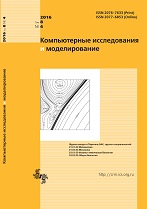|
This article is cited in 1 scientific paper (total in 1 paper)
ANALYSIS AND MODELING OF COMPLEX LIVING SYSTEMS
Methods and problems in the kinetic approach for simulating biological structures
V. V. Aristov, O. V. Ilyin
Dorodnicyn Computing Centre, Federal Research Center “Computer Science and Control”
of Russian Academy of Sciences,
40 Vavilova st., Moscow, 119333, Russia
Abstract:
The biological structure is considered as an open nonequilibrium system which properties can be described on the basis of kinetic equations. New problems with nonequilibrium boundary conditions are introduced. The nonequilibrium distribution tends gradually to an equilibrium state. The region of spatial inhomogeneity has a scale depending on the rate of mass transfer in the open system and the characteristic time of metabolism. In the proposed approximation, the internal energy of the motion of molecules is much less than the energy of translational motion. Or in other terms we can state that the kinetic energy of the average blood velocity is substantially higher than the energy of chaotic motion of the same particles. We state that the relaxation problem models a living system. The flow of entropy to the system decreases in downstream, this corresponds to Shrödinger's general ideas that the living system ‘feeds on’ negentropy. We introduce a quantity that determines the complexity of the biosystem, more precisely, this is the difference between the nonequilibrium kinetic entropy and the equilibrium entropy at each spatial point integrated over the entire spatial region. Solutions to the problems of spatial relaxation allow us to estimate the size of biosystems as regions of nonequilibrium. The results are compared with empirical data, in particular, for mammals we conclude that the larger the size of animals, the smaller the specific energy of metabolism. This feature is reproduced in our model since the span of the nonequilibrium region is larger in the system where the reaction rate is shorter, or in terms of the kinetic approach, the longer the relaxation time of the interaction between the molecules. The approach is also used for estimation of a part of a living system, namely a green leaf. The problems of aging as degradation of an open nonequilibrium system are considered. The analogy is related to the structure, namely, for a closed system, the equilibrium of the structure is attained for the same molecules while in the open system, a transition occurs to the equilibrium of different particles, which change due to metabolism. Two essentially different time scales are distinguished, the ratio of which is approximately constant for various animal species. Under the assumption of the existence of these two time scales the kinetic equation splits in two equations, describing the metabolic (stationary) and ‘degradative’ (nonstationary) parts of the process.
Keywords:
nonequilibrium open system, entropy, kinetic equations, ageing biosystems.
Received: 14.04.2018
Revised: 31.07.2018
Accepted: 11.09.2018
Citation:
V. V. Aristov, O. V. Ilyin, “Methods and problems in the kinetic approach for simulating biological structures”, Computer Research and Modeling, 10:6 (2018), 851–866
Linking options:
https://www.mathnet.ru/eng/crm689 https://www.mathnet.ru/eng/crm/v10/i6/p851
|

| Statistics & downloads: |
| Abstract page: | 282 | | Full-text PDF : | 100 | | References: | 33 |
|




 Contact us:
Contact us: Terms of Use
Terms of Use
 Registration to the website
Registration to the website Logotypes
Logotypes









 Citation in format
Citation in format 
